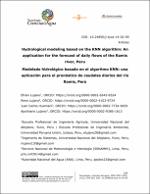Hydrological modeling based on the KNN algorithm: An application for the forecast of daily flows of the Ramis river, Peru
Fecha
2023Colecciones
Recurso(s) relacionado(s)
https://www.revistatyca.org.mx/index.php/tyca/article/view/2851Resumen
The forecast of river stream flows is of significant importance for the development of early warning systems. Artificial intelligence algorithms have proven to be an effective tool in hydrological modeling data-driven, since they allow establishing relationships between input and output data of a watershed and thus make decisions data-driven. This article investigates the applicability of the k-nearest neighbor (KNN) algorithm for forecasting the mean daily flows of the Ramis river, at the Ramis hydrometric station. As input to the KNN machine learning algorithm, we used a data set of mean basin precipitation and mean daily flow from hydrometeorological stations with various lags. The performance of the KNN algorithm was quantitatively evaluated with hydrological ability metrics such as mean absolute percentage error (MAPE), anomaly correlation coefficient (ACC), Nash-Sutcliffe efficiency (NSE), Kling-Gupta efficiency (KGE') and the spectral angle (SA). The results for forecasting the flows of the Ramis river with the k-nearest neighbor machine learning algorithm reached high levels of reliability with flow lags of one and two days and precipitation with three days. The algorithm used is simple but robust to make short-term flow forecasts and can be integrated as an alternative to strengthen the daily hydrological forecast of the Ramis river.







